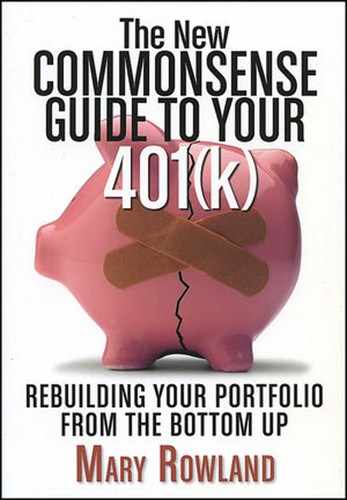ALTHOUGH YOU NEED not be a professional investor to make a good job of investing your 401(k) funds, I think it's worthwhile to look at some of the tools pros use to wring the emotion out of the investment equation. Emotions are a wonderful and necessary thing for a fulfilling life, but they have no part in investing. Most mistakes individual investors make come from emotions like fear and greed or, in the case of 2008 and 2009, sheer terror. Investing is a bit of science and a bit of art, but it should never be emotional. Selling on fear is another way to almost guarantee a loss.
One important investing tool is to examine correlation between different asset classes in your portfolio. Correlation measures the way two securities, mutual funds, or electronically traded funds perform relative to one another. Ideally, you want asset classes that perform well in different market environments. Accomplishing this is increasingly difficult because world markets more often move in tandem today. During the market plunge of 2008, it was impossible to avoid the disaster. Every asset class was hit at the same time, some more than others, true, but nobody escaped. Even careful experts like Ross Levin and his colleagues at Accredited Investors in Minneapolis got caught. Consider that in 2000, when the market lost 50 percent, Levin's client portfolios lost about 11 percent. But during the 2008 to 2009 period when the market lost 50 percent, Levin's portfolios lost 35 percent—better, to be sure, than it could have been, but that's because Levin is a professional investor who has been studying this stuff for most of his life.
So, before you begin to invest your 401(k) money, think about correlation. Holding uncorrelated assets does not guarantee that you will have a cushion and lose less in a market disaster, but it gives you a fighting chance. Holding all your assets in the same category almost sets you up to lose.
Let's assume that you use mutual funds for your 401(k) plan. You don't want two mutual funds that move in lockstep. If two investments move in tandem, professionals refer to that as a perfect correlation of 100 percent, or a correlation coefficient of +1.0. Two investments with a correlation of –1.0 would provide a perfect negative correlation. That would be a great help in building an investment portfolio, if only you could find them. Unfortunately, there are no two investments with a perfect negative correlation.
Yet investors are always on the lookout for investments that behave in different ways in the same environment because such investments decrease the risk in a portfolio. That's because when one asset class takes a dive, another one performs well. "What you want is one investment that zigs when another zags," says Don Phillips at Morningstar, the mutual funds research company.
All correlation measures fall somewhere between the perfect positive of +1.0 and the perfect negative of –1.0. Investment professionals consider investments with a correlation higher than 0.75 to be highly correlated and a poor choice for diversification.
Novice investors typically buy a group of funds with well-known names, believing they have achieved good diversification. Names mean nothing. Large funds are likely to hold the same well-known stocks that are touted by research reports. The bigger a fund is, the more difficult it is to find investments that are off the beaten path. Tiny companies don't have much impact on a giant fund. Consider the Fidelity Magellan Fund, which is still probably the best-known name in mutual funds and the one often selected for 401(k) plans. When I wrote the first version of this book in 1998, Fidelity Magellan had $63 billion in assets. As I revise it in 2009, Magellan contains about $15.53 billion. I think that indicates investors have gained wisdom since the days when Magellan was bought largely for its name recognition rather than its investment record.
This is an important lesson that many investors have learned in the past decade since I first wrote this book on 401(k) plans. Big name funds like Magellan and Janus and Windsor no longer get so many 401(k) plan investors simply because of their names. That doesn't necessarily mean that 401(k) plan investors are not making mistakes. They're making different mistakes, particularly with the introduction of target-date funds, managed accounts, and electronically traded funds, which I'll discuss soon.
